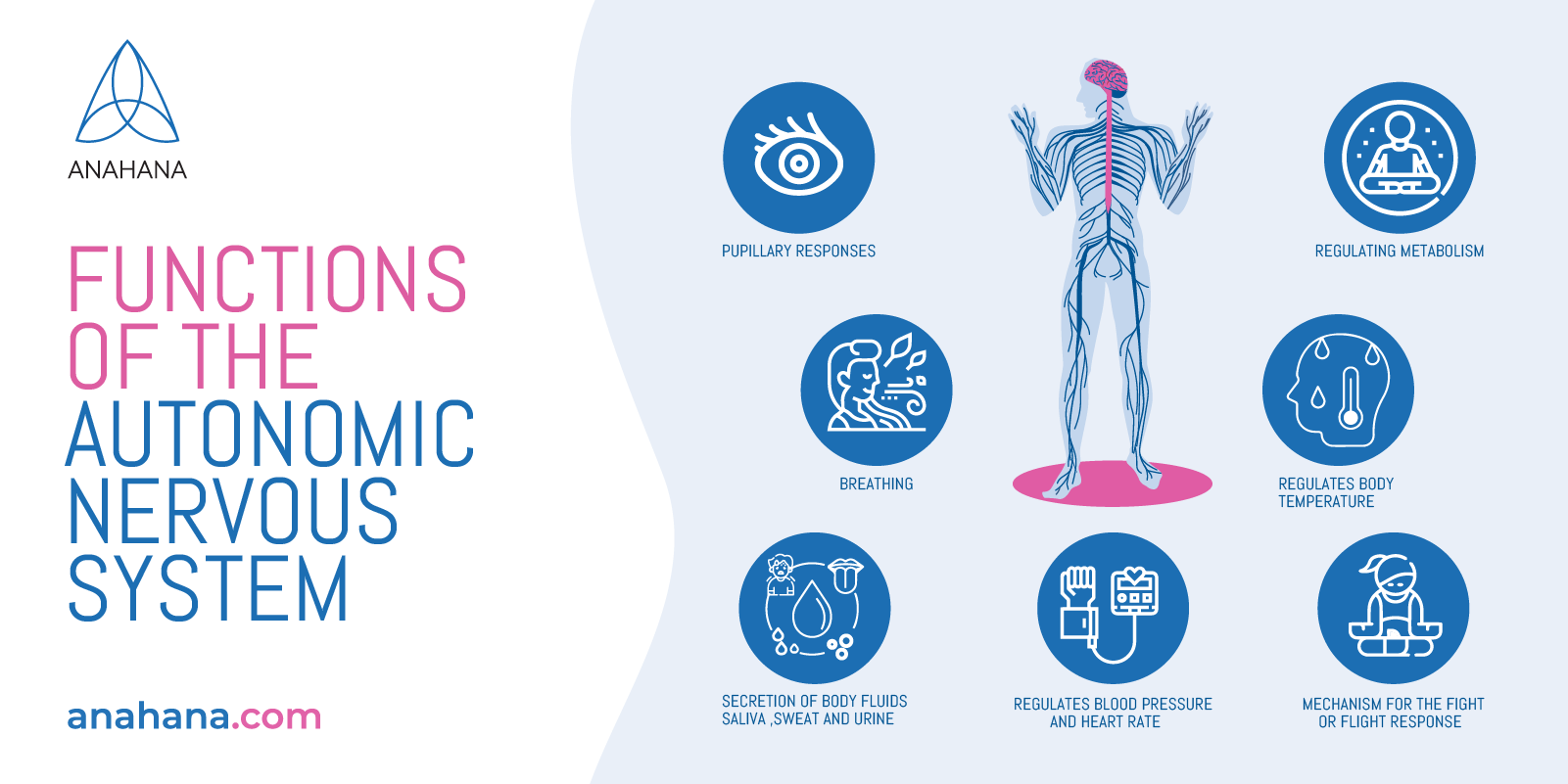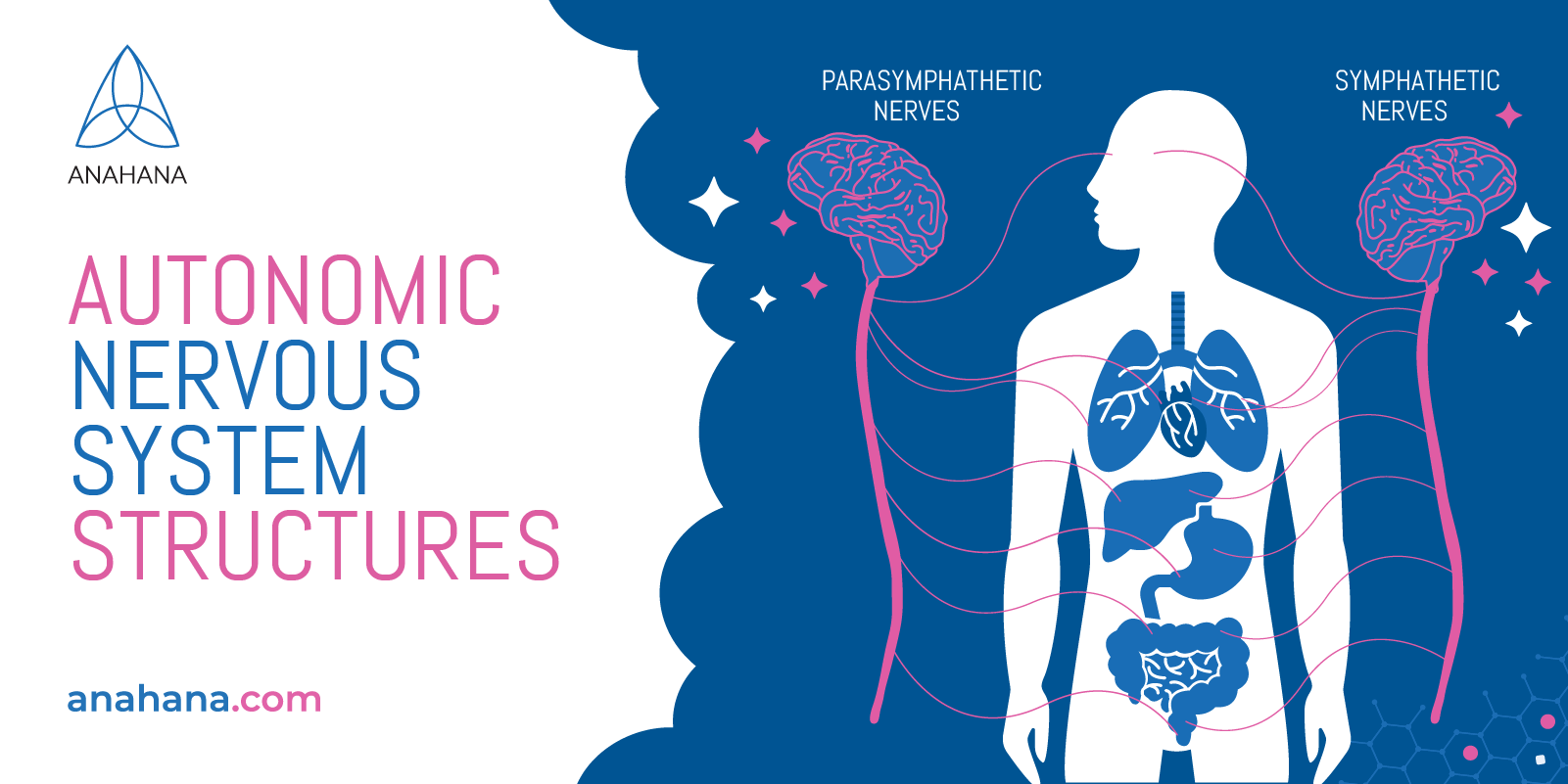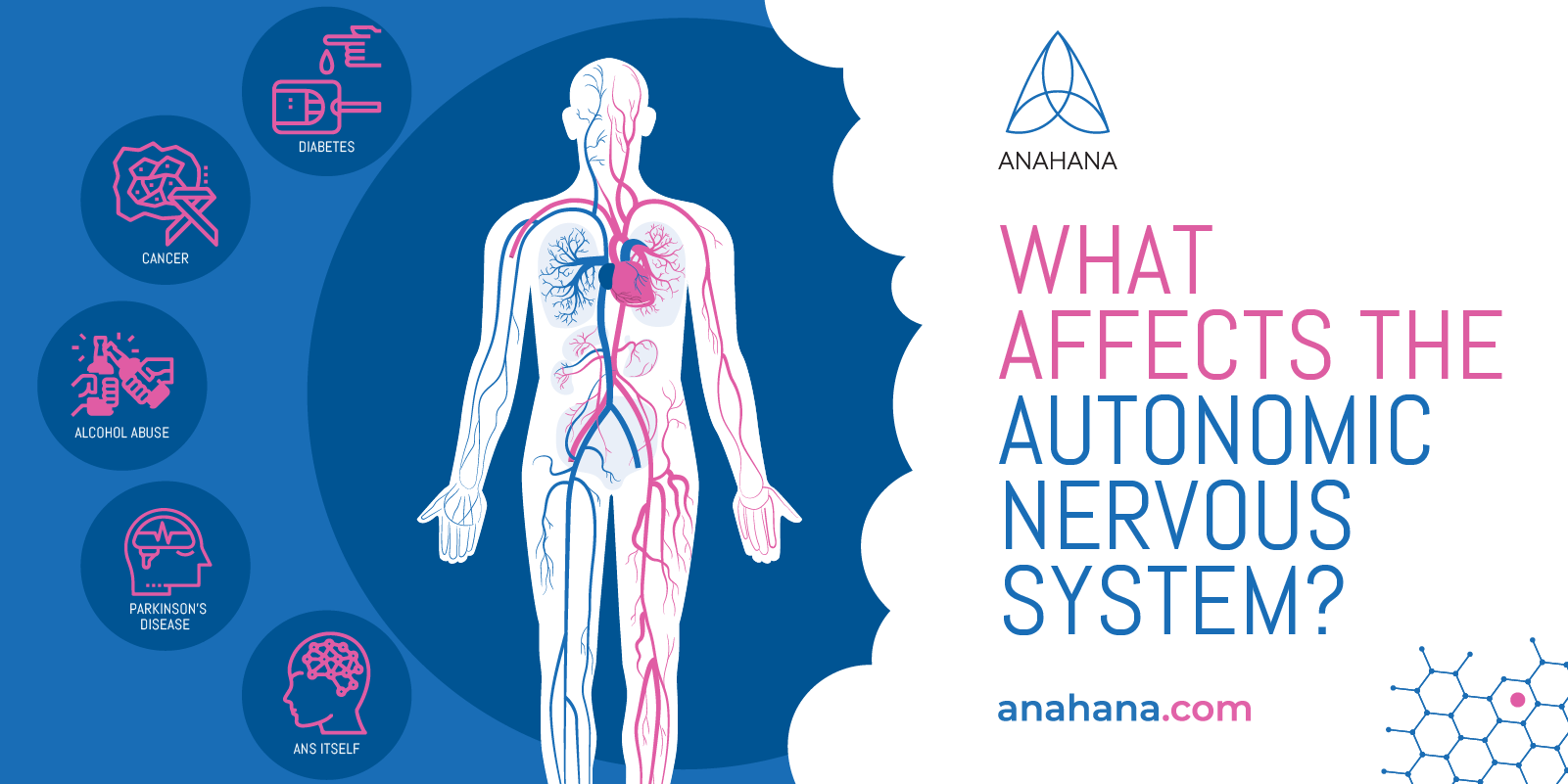
Table of Contents
Heartbeats, blood pressure, digestion: these vital functions occur without thought, all thanks to the autonomic nervous system. The autonomic nervous system controls all involuntary functions of the human body. It is part of the peripheral nervous system (PNS).
Key Takeaways
- Divisions: The autonomic nervous system (ANS) comprises the sympathetic, parasympathetic, and enteric nervous systems. These divisions regulate involuntary body functions such as heart rate, digestion, respiratory rate, pupillary response, urination, and sexual arousal.
- Sympathetic Nervous System: Often referred to as the "fight or flight" system, it prepares the body for stressful or emergency situations by increasing heart rate, dilating pupils, and inhibiting digestion.
- Parasympathetic Nervous System: Known as the "rest and digest" system, it conserves energy by slowing the heart rate, increasing intestinal and gland activity, and relaxing sphincter muscles.
- Enteric Nervous System: Sometimes called the "second brain," it governs the function of the gastrointestinal system. It operates independently but communicates with the central nervous system via the sympathetic and parasympathetic systems.
- Homeostasis: The ANS plays a crucial role in maintaining homeostasis by automatically regulating critical bodily functions without conscious effort, ensuring the body's internal environment remains stable and optimal for survival.
What is the Autonomic Nervous System
Human nervous function stems from the brain and spinal cord, the central nervous system (CNS). The PNS comprises all other nerves that branch to the rest of the body. It includes the somatic and autonomic nervous systems. The somatic nervous system controls the voluntary movement of skeletal muscle.
The autonomic nervous system has two primary subdivisions: the sympathetic and parasympathetic nervous systems. They typically act reciprocally to execute most unconscious bodily functions.
The sympathetic nervous system controls the fight-or-flight response and is most active in times of stress. The parasympathetic nervous system controls the rest-and-digest response and is most active in times of safety and relaxation.
The third subdivision of the autonomic system is the enteric nervous system. Its sole responsibility is regulating processes required for digestion.
What Are the Functions of the Autonomic Nervous System?
 The autonomic nervous system regulates involuntary physiological processes such as digestion, breathing, and blood pressure. Most of its functions occur in the sympathetic and parasympathetic divisions, which act in balance to maintain homeostasis in the body.
The autonomic nervous system regulates involuntary physiological processes such as digestion, breathing, and blood pressure. Most of its functions occur in the sympathetic and parasympathetic divisions, which act in balance to maintain homeostasis in the body.
Sympathetic and Parasympathetic Functions
The sympathetic nervous system is in charge of the fight-or-flight response. Its activity increases in situations such as heightened stress or exercise. Sympathetic activation aims to get you out of danger quickly. For example:
- Pupils dilate to improve vision.
- Airways dilate to increase oxygen intake.
- Heart rate and contractile strength increase.
- Arteries supplying the heart and skeletal muscles dilate while all other blood vessels constrict. This increases blood pressure and promotes blood flow to the heart and muscles.
- Muscle metabolism increases, breaking down stored glycogen and fat for energy.
Sympathetic activation also inhibits functions that might take up energy and slow you down, such as digestion and urination.
The parasympathetic nervous system controls the rest-and-digest functions. It is more active in times of safety and relaxation. Parasympathetic activation promotes growth, reproduction, and rest. For example:
- Pupils constrict.
- Heart rate and contractility decrease.
- Airways constrict.
- Salivation and gastric motility increase.
- Glucose is converted to glycogen for storage in the liver.
How Do the Two Divisions Work Together?
The sympathetic and parasympathetic nervous systems act reciprocally to one another. Both are in constant use, but activity seesaws toward one side or the other, depending on the situation.
Their nerves generally do not innervate identical targets. They may innervate different cells within the same organ to produce opposite effects. For example, pupil dilation is controlled by sympathetic activation of the dilator muscle, while parasympathetic activation of the sphincter muscle.
Parasympathetic nerves do not innervate as many tissues as sympathetic nerves. The reciprocal effect seen during parasympathetic activation is often due to a reduction in sympathetic activity. For example, although parasympathetic nerves do not innervate blood vessels, blood pressure decreases during parasympathetic activity.
Enteric Nervous System Functions
The enteric nervous system is all about digestive processes. The parasympathetic and sympathetic systems promote and inhibit digestion, but the enteric system controls the physiological mechanisms that allow digestion to occur.
Enteric nerves innervate muscle in the digestive tract to control the movement of food through the body. They also innervate the lining of the intestines to regulate blood flow, secretion, and absorption.
How is the Autonomic Nervous System Organized?
 The autonomic nervous system contains both sensory and motor nerve types. Sensory, or afferent, fibers carry information from the body back to the CNS. Motor, or efferent, fibers transmit orders from the CNS to the body to generate a response.
The autonomic nervous system contains both sensory and motor nerve types. Sensory, or afferent, fibers carry information from the body back to the CNS. Motor, or efferent, fibers transmit orders from the CNS to the body to generate a response.
Sensory input to the autonomic nervous system communicates the physiological state of the body. For example, chemoreceptors detect the amount of oxygen and glucose in the blood, while baroreceptors detect blood pressure. Autonomic afferent nerves are common to the entire system, they do not differentiate into sympathetic or parasympathetic.
Efferent autonomic nerves in the parasympathetic and sympathetic systems follow a two-nerve system, with ganglia that relay the signal between them. The first nerve is “preganglionic,” and the second nerve is “postganglionic.”
The enteric nervous system does not use the same two-neuron series as the rest of the autonomic nervous system. It also has its own sensory neurons.
Two-Nerve System
Preganglionic neurons have cell bodies (somas) in the brain and spinal cord. Their long axons extend into the periphery, where they synapse on the dendrites of closely-clustered somas. These clusters form the ganglia, the relay stations of the autonomic nervous system.
Sympathetic preganglionic nerves originate in the spinal nerves of the thoracic and lumbar spinal cord. Preganglionic parasympathetic neurons originate in the cranial nerves of the medulla oblongata, as well as sacral spinal nerves.
Sympathetic ganglia lie close to the spinal cord, so sympathetic preganglionic fibers are shorter than the postganglionic fibers. Parasympathetic ganglia lie close to the target tissues, so the preganglionic fibers are long, and the postganglionic fibers are short. Parasympathetic ganglia also intertwine to form nerve plexuses, which allows some integrative functions to modify the nerve signal.
Postganglionic fibers are the axons of somas that form the ganglia. They carry the nerve impulse the rest of the way and synapse on internal organs and glands. In the sympathetic nervous system, they are generally thin and unmyelinated. This means they lack the myelin sheath that often insulates nerve fibers. Postganglionic fibers in the parasympathetic system are relatively thick and heavily myelinated, so the impulse is well-insulated.
Distinct Organization of the Enteric Nervous System
Enteric nerve fibers form a complex web throughout the digestive tract. Many of the fibers create reflex pathways to allow rapid adjustments to digestive functions.
The enteric system generally controls the mechanisms of digestion independently of the rest of the nervous system. Some sympathetic and parasympathetic postganglionic nerves synapse on enteric nerves to modulate digestive function.
Autonomic Neurotransmitters
Autonomic nerve impulses are transmitted across synapses by small chemicals called neurotransmitters. Acetylcholine is the preganglionic neurotransmitter in both the sympathetic and parasympathetic systems. Acetylcholine is a common neurotransmitter throughout the body and also acts in the brain and the somatic nervous system.
The parasympathetic nervous system also uses acetylcholine as the sole postganglionic neurotransmitter. The sympathetic nervous system uses several different postganglionic neurotransmitters. Most nerves release norepinephrine, but those that signal to the sweat glands release acetylcholine.
Specialized cells in the adrenal gland, called chromaffin cells, use epinephrine. Chromaffin cells lack axons and release epinephrine directly from the ganglia into the veins to trigger systemic sympathetic activation.
The enteric nervous system uses various neurotransmitters, including acetylcholine, nitric oxide, and serotonin.
What Affects Autonomic Nervous System Health?
 The autonomic nervous system's sympathetic and parasympathetic arms must remain balanced to keep the body healthy. We need the sympathetic nervous system to take over during acute stress or danger. However, a chronic or frequent shift to sympathetic dominance and the reciprocal reduction of parasympathetic activity can lead to serious health issues.
The autonomic nervous system's sympathetic and parasympathetic arms must remain balanced to keep the body healthy. We need the sympathetic nervous system to take over during acute stress or danger. However, a chronic or frequent shift to sympathetic dominance and the reciprocal reduction of parasympathetic activity can lead to serious health issues.
What Are the Effects of Autonomic Imbalance?
Studies have found that overactivity of the sympathetic nervous system predicts the subsequent development of high blood pressure and obesity. This occurs through the dysregulation of metabolism, hormone signaling, and inflammation pathways.
High sympathetic activity can also lead to increased production of reactive oxygen species (ROS) or free radicals. ROS are produced naturally in the body and are vital to many cellular functions. However, excess levels can lead to oxidative stress, which damages DNA, proteins, and nervous tissue.
The combination of sympathetic overactivity and parasympathetic impairment can lead to type 2 diabetes and cardiovascular disorders, such as dysrhythmias. Loss of parasympathetic activity is also associated with lower quality of sleep, which can exacerbate other physiological and psychological issues.
What Can Cause Autonomic Dysfunction?
Many factors may contribute to autonomic dysfunction, also called autonomic neuropathy. A major predictor of autonomic dysfunction is chronic psychological stress, which causes a shift toward sympathetic dominance. Not all autonomic disorders involve autonomic imbalance, but it is a typical result. Other contributors to autonomic dysfunction include:
- Autoimmune disorders
- Diabetes
- Other degenerative neurological disorders (e.g., Parkinson’s Disease)
- Nutritional deficiencies
- Certain infections, including Lyme disease, tetanus, and HIV
- Alcohol use and smoking
- Side effects of some medications
Autonomic nervous system disorders can also result from genetic factors or injury to the brain, spinal cord, or peripheral nerves.
How Can I Protect My Autonomic Nervous System?
There are some things you can do to support your autonomic nervous system and try to shift dominance to the parasympathetic nervous system.
Reducing or eliminating sources of stress may help prevent sympathetic overactivity, but this is often easier said than done. Relaxing activities can also shift autonomic function towards the parasympathetic division, including yoga and slow breathing exercises.
Exercise can also be a great way to support the autonomic nervous system. Studies have found that consistent exercise training can increase parasympathetic activity, reduce the risk of autonomic dysfunction, and even reverse some damage in early cardiac autonomic neuropathy. It can also improve sleep, which benefits mood and overall health.
However, there are some caveats. One study on older adults with pets found that walking with their pets reduced stress and improved autonomic balance, but walking alone increased their stress and sympathetic activity. This suggests that it is essential to choose a type of exercise that you genuinely enjoy and does not add additional stress.
Exercising also increases the production of ROS in the body. The body produces antioxidants in response, which are beneficial for the autonomic nervous system. However, high-intensity or exhaustive exercise produces ROS levels too high for the body to compensate for, and oxidative damage can occur.
The recommendation is 30 minutes of moderate-intensity exercise five days per week. Keep in mind that exhaustive and moderate exercise definitions will depend on the individual and their fitness level.
A diet rich in antioxidants and anti-inflammatory factors supports a healthy autonomic nervous system and helps offset oxidative damage. Examples include extra virgin olive oil, turmeric, blueberries, pistachios, dark chocolate, and green tea.
Frequently Asked Questions
What is the autonomic nervous system and its role?
The autonomic nervous system is part of the peripheral nervous system, meaning the nerves that branch out of the brain and spinal cord. The autonomic system controls all the involuntary processes inside the body. Its three divisions are the sympathetic system (fight-or-flight), parasympathetic system (rest-and-digest), and enteric system (digestion).
What organs are regulated by the autonomic nervous system?
The sympathetic nervous system regulates more organs than the parasympathetic nervous system. The parasympathetic system innervates the eyes, lacrimal and salivary glands, heart, lungs, digestive tract, bladder, external genitalia, sweat glands, and liver.
Besides the female genitalia, the sympathetic system innervates all the same organs, the piloerector muscles, blood vessels, skeletal muscles, and fat tissue. Both systems innervate some aspects of the immune system.
How can I protect my autonomic nervous system?
You can protect your autonomic nervous system by promoting a shift towards parasympathetic dominance. Strategies include yoga, moderate-intensity exercise, breathing exercises and antioxidant-rich diets.
References
https://www.ncbi.nlm.nih.gov/books/NBK538516/
https://www.ncbi.nlm.nih.gov/books/NBK539845/
https://iopscience.iop.org/article/10.1088/1361-6579/aa6782
https://www.ncbi.nlm.nih.gov/pmc/articles/PMC3123705/
https://www.ncbi.nlm.nih.gov/pmc/articles/PMC8868289/
https://www.ncbi.nlm.nih.gov/pmc/articles/PMC8701130/
https://www.ncbi.nlm.nih.gov/books/NBK430888/
https://www.ncbi.nlm.nih.gov/pmc/articles/PMC5900369/
https://www.ncbi.nlm.nih.gov/pmc/articles/PMC6262541/
https://www.ncbi.nlm.nih.gov/pmc/articles/PMC5575449/
Disclaimer
The contents of this article are provided for informational purposes only and are not intended to substitute for professional medical advice, diagnosis, or treatment. It is always recommended to consult with a qualified healthcare provider before making any health-related changes or if you have any questions or concerns about your health. Anahana is not liable for any errors, omissions, or consequences that may occur from using the information provided.

By: Emma Lee
Emma is an editor for Anahana and a soon-to-be graduate of the Master of Science program at the University of Toronto. She graduated with a Bachelor’s in Neuroscience and Immunology at the University of Toronto and has extensive experience in research. She is passionate about learning the science behind health and wellness and hopes to contribute her knowledge to help people live healthier lives. Outside of Anahana, Emma enjoys exploring nature, playing with her dog, and doing arts and crafts.